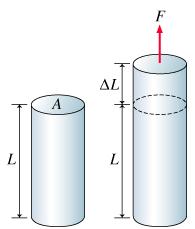Young's Modulus: Difference between revisions
Jlafiandra6 (talk | contribs) |
Jlafiandra6 (talk | contribs) |
||
| Line 28: | Line 28: | ||
#Is there an interesting industrial application? | #Is there an interesting industrial application? | ||
Young's Modulus was first developed in 1727 by the famous Leonhard Euler in Switzerland, but it was further expanded upon by Italian scientist Giordano Riccati in 1782. Finally, it was given a name by the British Scientist Thomas Young who finished work on it in the 1800s. It is used in order to discover the elasticity of solid materials and shows the stress per strain of a solid material. | |||
== See also == | == See also == | ||
Revision as of 12:35, 4 December 2015
This page discusses Young's Modulus and examples of how it is used.
Claimed by Jlafiandra6
The Main Idea
Young's Modulus is a macroscopic property of a material that measures how stretchy a solid material is. It is independent of size or weight, and it will change depending on the material.
A Mathematical Model
The definition of Young's Modulus can be expressed as: [math]\displaystyle{ {Y = \frac{stress}{strain}} = \frac{\frac{{F}_{T}}{A}}{\frac{{ΔL}}{L}} }[/math] where [math]\displaystyle{ {F}_{T} }[/math] is equal to the tension force, [math]\displaystyle{ A }[/math] is equal to the cross sectional area, [math]\displaystyle{ ΔL }[/math] is equal to the change in length due to the tension force, and [math]\displaystyle{ L }[/math] is equal to the new length of the material.
A Computational Model
Examples
Be sure to show all steps in your solution and include diagrams whenever possible
Simple
Middling
Difficult
Connectedness
- How is this topic connected to something that you are interested in?
- How is it connected to your major?
- Is there an interesting industrial application?
Young's Modulus was first developed in 1727 by the famous Leonhard Euler in Switzerland, but it was further expanded upon by Italian scientist Giordano Riccati in 1782. Finally, it was given a name by the British Scientist Thomas Young who finished work on it in the 1800s. It is used in order to discover the elasticity of solid materials and shows the stress per strain of a solid material.
See also
Are there related topics or categories in this wiki resource for the curious reader to explore? How does this topic fit into that context?
Further reading
Books, Articles or other print media on this topic
External links
Internet resources on this topic
References
This section contains the the references you used while writing this page
